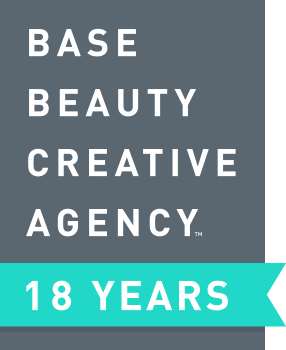Recently, members of our marketing and creative teams hosted a year-end webinar titled 2023 YearEnder Mega Moments. This fascinating look at Base Beauty’s wins and learnings was attended by clients, colleagues, and industry friends. It was an exceptional gathering and a celebration of some highlights of 2023, plus a look at what’s to come in 2024. I was incredibly proud of our team for their insights, inspirations, and polished presentation.
One of the most critical topics for all of us, from marketers to creatives to brands, is how, ready or not, AI will increasingly become a part of our lives. At Base Beauty, we’ve been getting ready for a while. No longer the elephant in the room that nobody talks about, the world of AI, with its possibilities and challenges, is here to stay. Our vice president of design, Elisa Vitale, provided an outstanding overview of what AI can and cannot do as a creative design tool.
Elisa started by reminding us that AI has been here for a while, from search engines to navigation apps to word and grammar suggestions in our writing to digital assistants such as Siri and Alexa. But it’s only recently that it has burst onto the scene as a robust creative tool.
Today, AI can be used for image generation, image editing, video editing, even storyboarding, complete with sketches and camera angles. Elisa touched on the possibility, someday, of not even having to do photo shoots, relying entirely on AI-generated images. Obviously, that will be a sea change, when it happens, but it’s not here yet. All of us at Base Beauty, including me and our COO, Aleni Mackarey, Ph.D., MS, have been immersing ourselves in learning all we can about how to use the tools AI offers. We always want to be ahead of the curve.
But—and this is a significant but—Elisa spoke of how AI is not quite ready for prime time. It will evolve, but she listed some of AI’s current limitations:
- It can be challenging to make a series of images in the same style, which is crucial for a particular client or campaign.
- You can’t always predict how AI will interpret your written directions.
- If you have a very specific idea, you must provide complex descriptions, including camera angles, lenses, lighting, and art styles, for the best results.
- AI-generated images can lack the fine details and realism of a photo.
- AI struggles to incorporate text accurately within images.
- AI often produces biased image outputs that may reinforce racial, cultural, or economic stereotypes of beauty, which is a huge issue in the beauty industry in general and especially for Base Beauty, where we prioritize inclusion and representing beauty in all its shapes, sizes, colors, and styles.
- AI-generated images cannot be copyrighted since its output is based on the millions of images it’s been trained in.
After pointing out these challenges, Elisa pivoted to illuminate how AI tools can be enormously valuable despite their current imperfections. She showed two examples from our client work:
- To reshape an ad for which there was not enough of a background of foliage, she instructed the new generative fill options in Photoshop on what she needed. Something that once would have taken her hours of searching for the perfect stock images and then seamlessly blending them with the original took her about 10 minutes.
- Needing a stock image of a joyful man with red accents in his clothes, Elisa found a face we all loved but with no red accents. So, she prompted Photoshop to replace his brown hat with a red fedora, and a minute later, she had the image she needed.
These examples illustrate how AI tools can save content creators time, which saves clients money, which saves everyone frustration and hours of grunt work. I suggest we think back to the time-saving, money-saving inventions of modern times, from the telephone to the typewriter to the dishwasher. Incorporating them into our daily lives required flexibility, adaptability, and steps into the unknown. But look at how they have improved our lives! We should think of AI in that way, offering valuable tools that can help us put more creativity and thought into our work and give us more time for other pursuits.
There are clearly huge implications with AI that did not exist with the dishwasher, which did not threaten to turn our dirty dishes into something unrecognizable, inauthentic, or misleading. But that’s a discussion for another time. For now, let’s embrace this remarkable technology and welcome all it can do for us.
Message our CEO with your thoughts: How are you bringing AI into your business and your life? What challenges have you faced in stepping into this new world? Please share!

